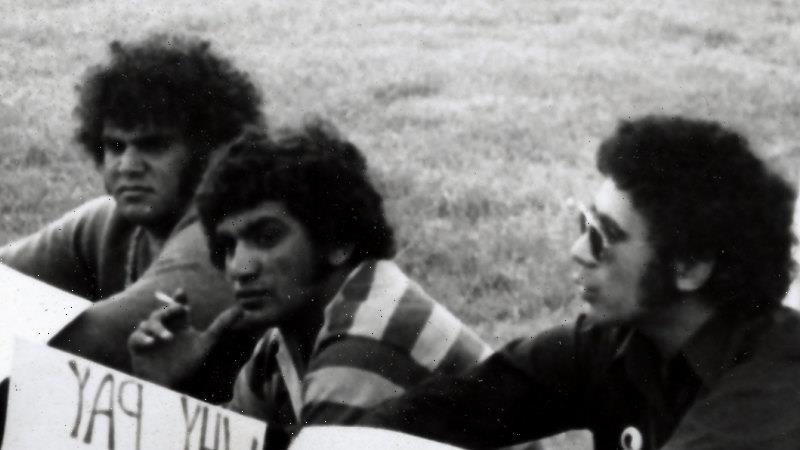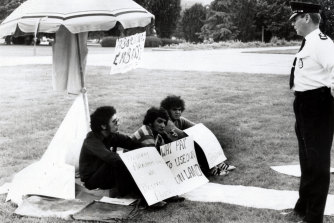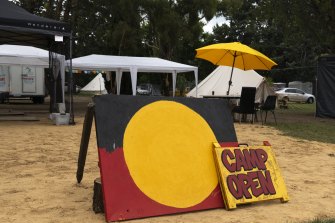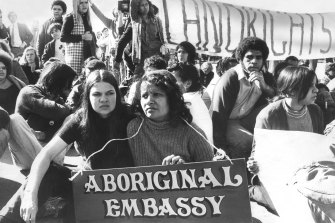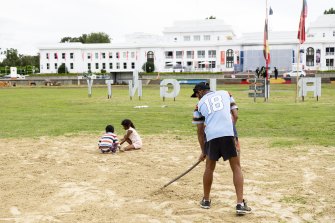The golden jubilee of the Aboriginal Tent Embassy in Canberra could not have arrived at a more opportune moment. In a year when many January 26 protest marches have been either postponed or curtailed due to the Omicron variant of COVID-19, it’s apt that the focal point for the day will now shift to commemorations being held around a campfire on the lawns of Old Parliament House.
It’s been a tumultuous eight weeks for the heritage-listed embassy. In the past fortnight it’s successfully repelled a hostile takeover by a predominantly non-indigenous protest group that aimed to use it as cover in a planned violent assault on the Commonwealth’s former parliament.
The original Aboriginal Embassy: Mike Anderson, NSW Aboriginal Lands Board vice-chairman, Billie Cragie of Moree, Kevin Johnston of Nowra and Inspector G. Grove of the ACT Police.Credit:Archive
The embassy was also compelled to distance itself from a pair of arson attacks carried out by the new group in December, the most serious of which razed the old parliament’s front doors and historical portico. The embassy, its council, and Indigenous activists camped there were also allegedly targeted with attempted arson attacks, intimidation, physical assaults and damage to property.
But according to historians of the long-running protest, the latest scrap pales beside the embassy’s tumultuous past – a history which, over the last two decades, has become increasingly obscure for large sections of the public, including many younger First Nations people.
This is despite the documented political and social significance of the Tent Embassy to the national narrative.
Duplicity and deceit
On January 26, 1972, four Aboriginal men, Tony Coorey, Bertie Williams, Michael Anderson and Billy Craigie, set out for Canberra after being outraged by a statement made by Prime Minister William “Billy” McMahon over the radio earlier that day.
The Aboriginal Tent Embassy on Monday.Credit:Rhett Wyman
The issue of Aboriginal land rights was a focus of both national politics and the rising Indigenous Black Panther movement in Australia at the time. The big issues were land claims of the Yirrkala Yolngu people against the Nabalco international mining consortium in Arnhem Land and the Gurindji people in Central Australia, whose protest at Daguragu-Wattie Creek was more about reclaiming their land than it was about equal wages and work conditions.
McMahon’s offending statement acknowledged “the deep affinity between Aboriginal people and the land”, but went on to assert that there would be no land rights as they would “lead to uncertainties and possible challenge in relation to land titles in Australia which are presently unquestioned and secure”. McMahon also declared that although assimilation was a now a matter of choice, “separate development as a long-term aim is utterly alien” to the government’s objectives.
When the four Aboriginal men arrived at the lawn, erected a beach umbrella and fixed a placard designating the site as the Aboriginal Embassy – an idea of poet Coorey, according to scholar and activist Professor Gary Foley, a prominent figure of the embassy’s earliest iterations. The same day, members of the Black Caucus – as the Black Power movement in Australia was known – began to arrive en masse.
By July 1972 the embassy had grown.Credit:Archive
Many had been attending an anti-racism conference at the University of Queensland in Brisbane to challenge white university student activists to do more to confront racism in Australia rather than elsewhere in the world, and to step down from some roles in favour of Aboriginal candidates. The activists included Foley, then 21, Paul and Isobel Coe, Alana and Savannah Doolan, Cheryl Buchanan, Ambrose Golden-Brown, Charles “Chicka” Dixon, Bruce McGuinness and Marjorie Thorpe, among others.
In the days and weeks that followed, others arrived from all states and territories in support, many now recognisable names in Aboriginal rights advocacy: John Newfong, Denis Walker, Roberta Sykes, Pearl Gibbs, Shirley Coleen Smith (known as Mum Shirl), Bob Maza, Brian Lovett, Gary Williams, Lyn Thompson, Pat Eatock, Sam Watson, Naomi Mayers, Gordon Briscoe, and others. International activists, including Sekai Holland and the leader of the Polynesian Panther Party, Will ’Ilolahia, also joined.
Twice the embassy was torn down by police, the first time on July 20, 1972. Ten days later, protesters re-established it accompanied by about 2000 supporters, before it was against forcibly removed. On December 13 that year, the ACT Supreme Court declared the embassy’s removal was illegal. It was re-established and remained on site until February 1975, when an agreement was reached for it to withdraw to various locations around Canberra. In 1992, its 20th anniversary, it moved back to the Old Parliament House lawns.
Descendants of the original activists remain closely involved with the embassy and are leading the organisation of the 50th anniversary events that begin on Tuesday.
The embassy is one of the world’s oldest continuous protests.Credit:Archive
The embassy’s greatest impact on the national political stage came in the first few weeks following January 26, 1972. From February 5 to 6, members of the Black Caucus drew up a five-point petition to present to government which demanded control of Northern Territory, legal title and mining rights to all other reserves and settlements in Australia, including all Australian cities, as well as the protection and preservation of Aboriginal sacred lands. It also demanded $6 million in compensation for all lands lost and an annual percentage of the gross national income.
Then opposition leader Gough Whitlam visited the embassy on February 8 to discuss the petition, and left offering public support and promising Aboriginal land rights. At a rally organised by the embassy on February 22, Whitlam spoke. And in his election speech on November 13 that year, Whitlam said: “We will legislate to give Aborigines land rights, not just because their case is beyond argument, but because all of us as Australians are diminished while the Aborigines are denied their rightful place in this nation.”
Upon taking office in 1973, the new Whitlam government granted land rights in the NT where it had control. Elsewhere, though, state governments refused to back the legislation, and the push for national legislation was eventually shelved.
Foley says embassy leaders felt Whitlam had reneged on his promise.
The embassy and Australia Day
To the core embassy protesters, McMahon’s speech, but particularly its delivery on Australia Day, was a deliberate provocation. According to Foley, McMahon’s choice of such a strongly contested and controversial day as the one known to Aboriginal Australia as Invasion Day was “extremely provocative”, and went against the advice of the government’s own appointed Council for Aboriginal Affairs.
It “inevitably agitated the young black radicals of Redfern,” he says.
Archival footage of the embassy’s earliest iterations shows placards reading “No Pride in Genocide”, the fore-runner of today’s Abolish Australia Day movement.
William McMahon in 1971.Credit:Archive
The embassy’s activism finds modern expression in protests against Australia Day, which most Aboriginal people now call Invasion Day, Day of Mourning, or Survival Day. For the past decade there has been a growing movement to reshape the way the Australian public thinks about the day.
The “change the date” movement emerged in the early 2010s, and the slogan quickly became embedded into the views of white supporters of Indigenous rights and adopted by progressive political parties. In the middle years of the past decade, Blak activist group the Warriors of Aboriginal Resistance adopted a policy to “abolish Australia Day”. The move has gathered supporters particularly amid the rise of the global Black Lives Matter demonstrations in 2020.
“It’s understanding that true history of the country and what has happened to Aboriginal people. That history didn’t just happen on January 26. It’s about abolishing the mindset of white superiority over Aboriginal people,” says Warriors of the Aboriginal Resistance co-founder Boe Spearim. “White Australia is still holding institutions that are harmful towards Aboriginal people to this day.”
Spearim says the expression also challenges the non-Indigenous people who might turn out for Aboriginal rights on January 26, but who for the rest of the year ignore issues impacting Aboriginal lives.
Aboriginal Rights campaigner, scholar and descendent of the Yiman peoples, Professor Marcia Langton says the idea of Australia needs to be based on 65,000 years of history, “not a muddled concoction from some historical records.”
“January 26 is an ex post facto invention. It’s a muddle of ideas. None of which are correct,” she says.
The embassy commemoration
The earliest details of the embassy’s history were chronicled poorly in the past, Foley says, and as a political phenomenon, it has also been overlooked or disregarded by political leaders – sometimes wilfully, sometimes inadvertently. So from the perspective of First Nations peoples, the Tent Embassy remains a symbol how Indigenous communities are treated around the country.
“It stood for and remains to this day a symbol of Aboriginal resistance to government indifference, duplicity and deceit,” Foley told The Age and The Sydney Morning Herald ahead of a series of seminars about the embassy titled “Black Fire”, held over the weekend.
Activists prepare the embassy grounds for the 50th anniversary celebration this week.Credit:Rhett Wyman
“The Embassy brought international awareness of the land justice issues in this country and an end to the assimilation era when it forced Whitlam to change policy after he became prime minister the following year.
“It was also the final destabilisation of the McMahon government, ending 23 consecutive years of the conservatives being in power,” Foley says.
The milestone will be celebrated on the old embassy site with three days of workshops and panels on land rights, governance, truth telling, treaty and sovereignty running alongside exhibitions and cultural activities.
The embassy numbers will swell as delegations from First Nations around the country arrive in Canberra. Organisers are hoping that thousands will show. Guests have been invited by the embassy council to register and stay for seven days.
Finally, an “Australia Day” celebration that Indigenous people can get involved in.
The Morning Edition newsletter is our guide to the day’s most important and interesting stories, analysis and insights. Sign up here.
Most Viewed in National
From our partners
Source: Read Full Article
